ALL ABOARD
No skimping on the good stuff for chef Mynhardt Joubert
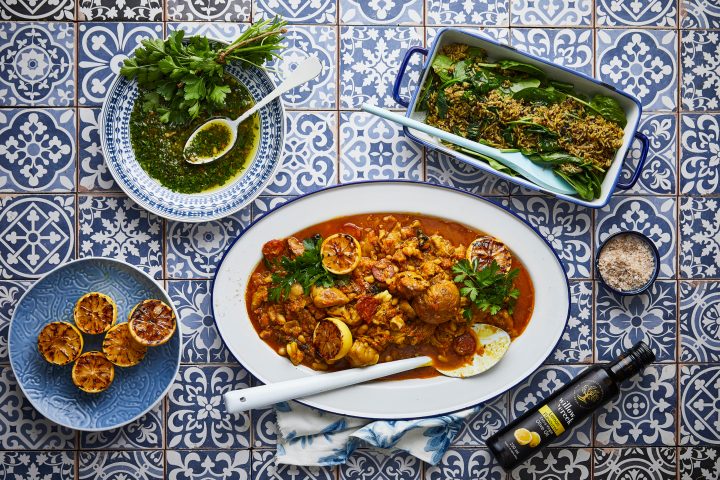
Chef Mynhardt Joubert is a champion of indigenous ingredients, which carry childhood memories in every mouthful. His generosity is apparent in everything he cooks, whether it’s on the table at his home restaurant in Paarl, or delivered further afield.
Over the years, various deliveries have arrived for me from chef Mynhardt Joubert, every one of them a delight – not only for the food contained therein but for the thought and care, and a dash of dramatic flair, that goes into the presentation.
Of course, now I’ve said that, I can’t remember enough to describe any of them (except the most recent) but I still think about those lavender heart-shaped shortbread biscuits with great fondness. The end of October has become an annual tradition, with the arrival of the festive fruitcake which requires two months of careful feeding with brandy, until it can hold no more. Soaked and too soft to be cut with a knife, it’s spooned into bowls at the family lunch, with great big dollops of whipped cream.
This is worth mentioning because until I’d had my first one from Joubert, I was not a fan of the fruitcake. Or even Christmas pudding for that matter. It was something my granny made well in advance, after shopping for the ingredients at Wellington Fruit Growers in Darling Street, which always smelled so rich and heavenly, and included making a wish while standing on a stool and stirring, but it never appealed. The copper and silver coins, well boiled before the time, were a small consolation as the pudding was poked apart and pushed aside to reveal its potential treasure. Eating it was an unfortunate side effect of the whole situation.
Joubert’s fruitcake changed all that. When the first one arrived along with a bottle of jolly fine KWV brandy, I decided to give it a go. Google offered a formula for the feeding of the cake – the dribbling in of brandy over several weeks. I measured it out, looked at it, and decided that it was a stupidly small amount, and doubled it … and the frequency. The logic behind this was that the brandy could only improve the cake. You see now why the cake ends up the way it does. The bar was set high that year.
The thing is, the cake is actually really good. It’s as generous as you’d expect, coming from Joubert’s kitchen, and it’s, well, fruity and nutty. There’s no skimping on the good stuff.
None of this happened by accident. Said Joubert: “I have also not ever been a fan of the Christmas cake until one year when I was very low and going through an extremely bad patch in my life, a parcel arrived from my sister in the Eastern Free State – a Christmas cake in an old-school tin with a beautiful letter … it was everything that I had not expected – soft, moist, flavourful and packed with cherries and nuts, and none of the dark, ominous, dry fruitcakes that I had tasted growing up.
“The original recipe was from Arina du Plessis from Landbou Boerekos’ mom – I wrote to her and asked if we could possibly use the recipe and start baking the cakes. She kindheartedly agreed and since then we have tweaked and adapted it to make it our own.”
So who is Mynhardt Joubert anyway? As per the biog: “restaurateur, television personality, KWV food ambassador, entrepreneur, stylist and recipe developer”. He’s also a talented photographer, and he can grow orchids, which is a hugely impressive skill to have in one’s arsenal. Station Street Kitchen is his restaurant in Paarl, where guests can book, not merely for dinner or lunch, but a culinary experience. “Dining in my home restaurant makes guests feel pampered and at ease. A group of 10, maximum 30 guests, is seated at a long table, with a menu just as long,” said Joubert.
Station Street Kitchen is what its name implies; it’s right near the station with all its hustle and bustle. Go through the door and up the stairs and you’ll find yourself in a large kitchen/dining room. Beyond that, a sunken lounge filled with glorious vibrant décor – and all those orchid plants. Somewhere nearby but private, Joubert lives with his husband, Ian Engelmohr, who is a ceramicist.
“I was looking for accommodation in Paarl after moving from Riebeek Kasteel where I owned and ran Bar Bar Black Sheep Restaurant – it was a very creative space, and I needed something really special to fill that gap.”
The 24 Station Street venue is on the roof of an old “corner shop” building, and was beautifully renovated by the landlord, Amor Strauss.
“The property is across from Paarl station and I always jokingly refer to the fact that ‘I live on the wrong side of the tracks’, but I love it! It is a loud and noisy station with taxis coming and going all day. But it is vibrant and a true reflection of South Africa,” said Joubert.
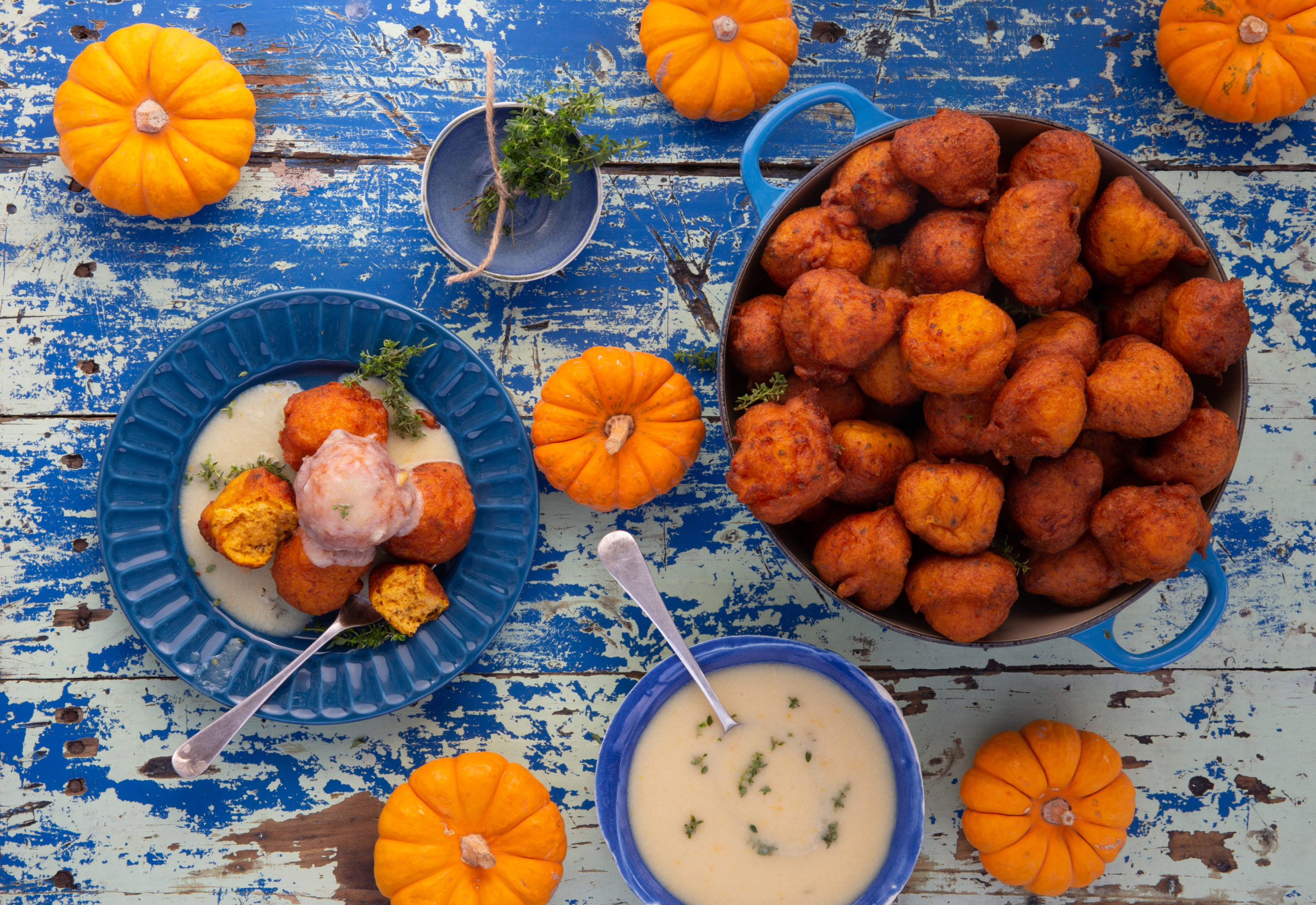
Mynhardt Joubert and his team survived lockdown with readymade meals, like these pampoenkoekies, made with aniseed and served with an orange and thyme caramel sauce. (Photo: Supplied)
Covid-19 is a reset button to do things differently and reconnect with what matters – the luxury of simplicity and a slower pace, he continued. “I fell in love with my kitchen all over again, cooked with the season, rediscovered time-honoured techniques like canning, pickling and jam-making. Even as the situation returns to the new normal, we’ll stay with the essence of how we do things now.”
Station Street Kitchen will still hold delicious food with great wine and beautifully set tables at its core, although opulence and flamboyance now make way for a more pared-down approach. “The bounty of nature, the homemade and the handmade, now count as the real luxury,” said Joubert. “Our guests also appreciate that we source everything from local farmers and small suppliers in our area.
“We will be offering family style tables and plated lunches and dinners for group bookings as before and focus even more on making people feel safe in a loving environment. The space is very disarming and makes you forget about the world outside – we offer escapism in the best possible form.”
To celebrate the reopening and to illustrate this ethos, Joubert sent not one, but two bags of goodies which represented him, where he grew up, and the local, often humble, produce which he loves so much. For example, a bunch of asparagus. Not the skinny kind, but a fistful of big, strong stalks. I remember from an event I attended at the Kitchen that it’s one of Joubert’s favourite ingredients. It can be fancied up in a dish or savoured unfussily with brown bread, garlic butter and brown vinegar.
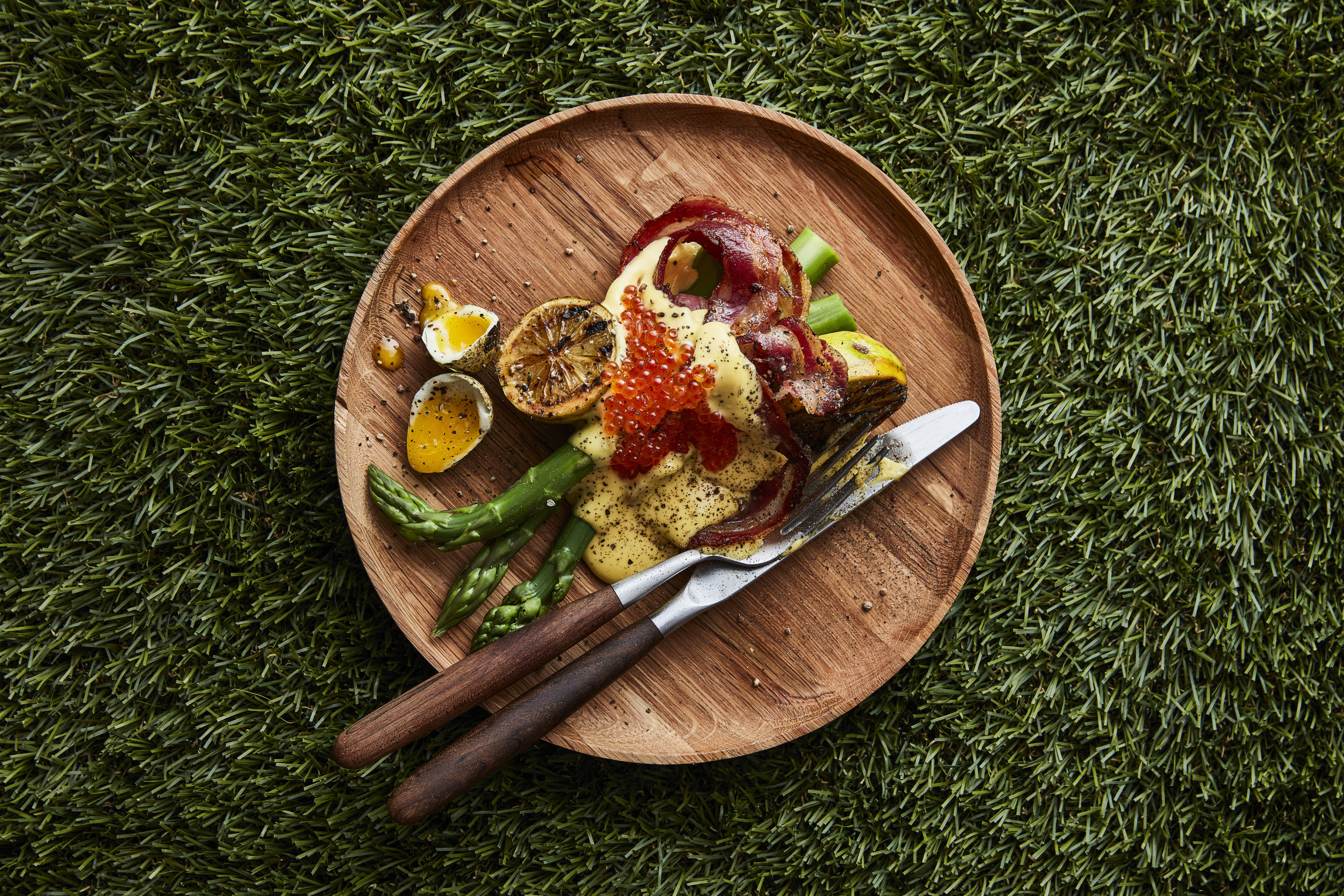
Asparagus is one of Mynhardt Joubert’s favourite ingredients, fancy like this, or simple. (Photo: Supplied)
“Asparagus is part of my DNA – I’m sure of it,” laughed Joubert. “I just love when the season starts and could it eat every day in its simplest form as above or all jazzed up with Hollandaise sauce, pancetta, caviar, Parmesan and pine nuts.”
I charred mine in a griddle pan and had them for breakfast with proper poached eggs, streaky bacon and the magic aioli made in two minutes from a recipe on the internet, Buck’s Fizz on the side.
Then there was the nastergal jam. It’s a deep, rich, royal purple and unlike any jam you’ve had before. In English, the plant is Nightshade. Isn’t that poisonous, my mother wanted to know. Yes, the leaves and stems are, but the berries are edible. One has to wonder how long it took humans to figure that out, which only adds to its attraction. “Nastergal is indigenous to the Eastern Free State and Natal Highlands, where I know if from,” said Joubert. “My Tannie Yvonne used to make a huge variety of jams and perfected the art of cooking nastergal. She has, unfortunately, passed away and has taken all her jam cooking secrets with her…
“Nastergal has always been eaten on bread, especially mealie bread. We have used it with double cream yoghurt in trifle and it can be made into a delicious homemade ice cream. I love its unique colour!”
Me: Slap that good stuff on my toast and get in my face.
You can find it in the Cape at Mooiberge strawberry farm in Stellenbosch, Goedehoop Slaghuis in Paarl, and all over the eastern Free State, especially Clarence.
Not in the bag of goodies, with items individually wrapped and packaged in cloth and hessian bags tied with string, the mielie bread wrapped in paper – it really was as if Christmas had arrived early – but a firm fave with Joubert, is offal. Some of you may be squeamish about this but do give it a try. Properly prepared, it’s a revelation, and Joubert’s recipes could convince you. Or think of it this way: if you’ve ever had steak and kidney pie, or chicken liver pâté, you’ve technically already eaten offal, so it’s only a matter of expanding your horizons.
“I have an obsession with nose to tail cooking like sheeps’ tails, slow cooked lamb tongues, lamb hearts and chicken gizzards – offal of every kind, from the traditional ‘Vaal afval’ I grew up with to the way the Italians and Portuguese make this delicacy.
“Make sure it comes from a reputable source and that it is sparkling clean and holds no smell. I order all my tripe from Deli-Co Farmstyle Family Butchery in Riebeek Kasteel – the quality is phenomenal,” advised Joubert.
Using local ingredients is very important to Joubert, and he’s always loved cooking with them; growing his own it is just common sense, he said. “It’s closer and more affordable and it tells the story of an area. I am very fortunate to be able to live in the Cape where there is such a strong focus on local ingredients. We are very spoilt.”
If the ingredients are not readily available, Joubert’s best advice is to find a suitable substitute, be adventurous and experiment. “This way the recipe becomes your own and you start telling a new story and make new memories,” he said.
Memories are a big part of who Joubert is, and what he does. “I was infatuated with making fires from a very, very early age … needless to say that some holiday tents almost went up in flames,” he recalled. “Instead of getting a beating my dad took me aside and taught me how to make a proper fire and be safe about it. Ever since, I am in love with cooking on open fires and with natural fuels – there is just something so special about low and slow cast iron fire cooking. Apart from the traditional braai, potjiekos is very much part of my history and probably one of my favourite things to make and I have a large collection of drie poot potte.”
Besides being a fire bug, young Joubert found a place that felt like home: on stage as a ballet dancer. “My very liberal mother allowed me to take ballet lessons after I watched my sister in class at the age of six. This was no small feat as I grew up in a very conservative rugby playing farming community. I met a wave of resistance and quickly became an outcast but it shaped me in ways that I am very grateful for today,” shared Joubert.
“After school I studied Musical Theatre at Pretoria Tech which completely blew my mind! I had friends for the first time in my life and studied and partied hard for four years. After tech I did a couple of musicals and then auditioned for PACT ballet company until the year all the State funded theatres were closed down. I joined Richard Loring’s African Footprint and toured overseas; upon my return I had to decide which avenue my life would take and then food and wine followed…”
After working at the Royal Hotel and Cafe Felix in Riebeek Kasteel, Joubert met Anton Espost, who completely revolutionised everything he had ever thought about food – and especially wine. “He asked me to partner with him and his idea was to create a peasant style workers’ restaurant.”
Enter Bar Bar Black Sheep, where I sat many times with icy jugs of Pimm’s filled with summer fruit, making friends with locals. And if it was the right time of the year, courgette blossoms in tempura batter, stuffed with goat’s cheese if I recall correctly.
“It evolved slightly from there but so much of me was formed in those years. The restaurant was completely hidden away at the bottom of an alleyway and Anton’s words of advice were: ‘Just cook good food – they will come’ … and they came!” said Joubert.
“We had BBBS for five years and I treasure those very, very special years in my heart.”
Mine too, Mynhardt. Mine too.
For more information, click here.
Have a go at these recipes by Mynhardt Joubert:
Trippa alla Roma/Roman ‘Tripe and Trotters’/Romeinse Pens en Pootjies Afval
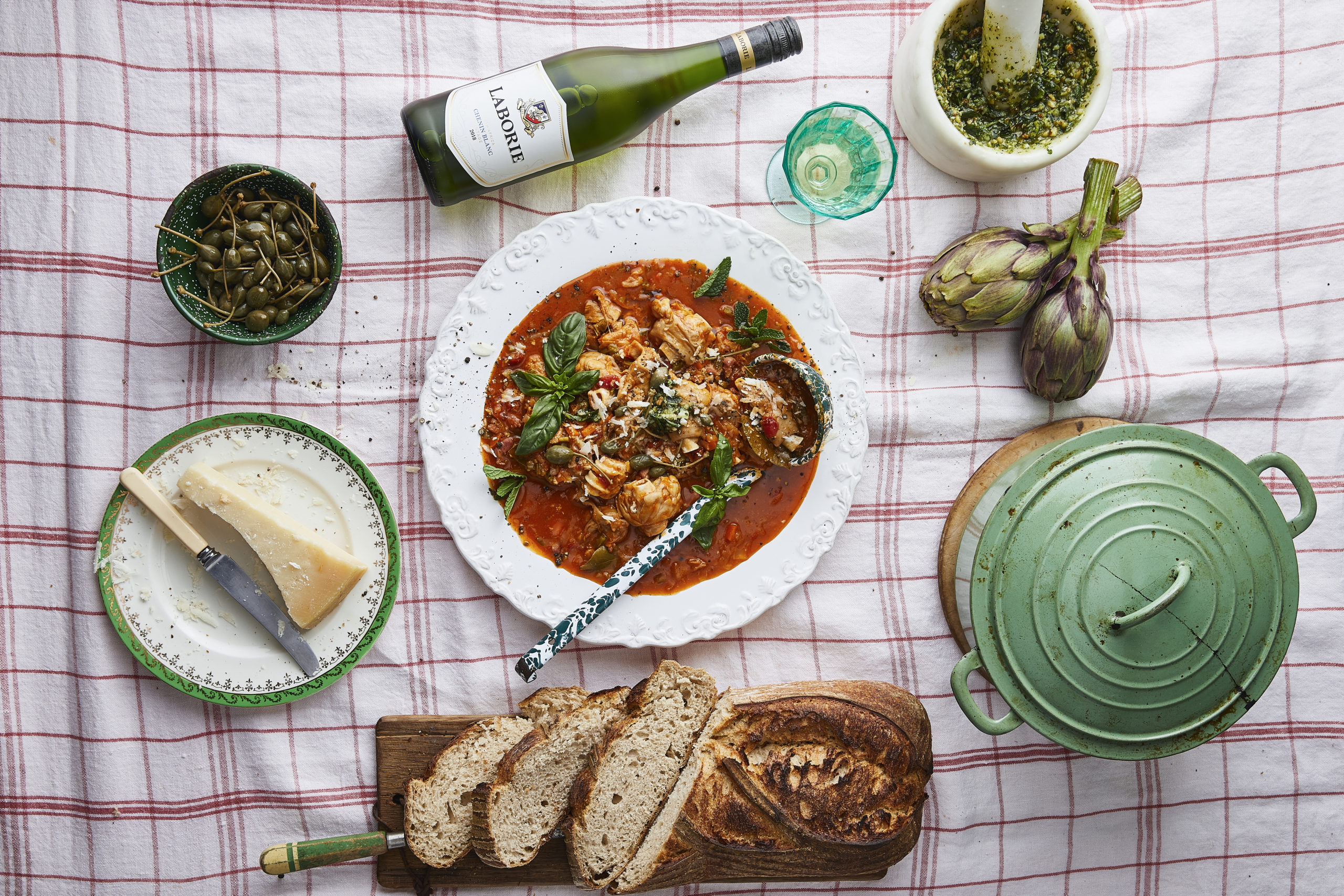
‘Trippa alla romana, or Roman-style tripe, is one of the most flavourful ways of enjoying tripe that I know of,’ says Mynhardt Joubert. (Photo: Supplied)
“Tripe was once a common part of the Italian diet, and nowhere more so than Rome. The inhabitants of the Eternal City are famous for their love of offal, which they jocularly call the quinto quarto, or the ‘fifth fourth’, a butcher’s term for those humble parts of the animal that the nobility and clergy left for the common folk. Saturday was the traditional day in Rome and elsewhere in Italy to eat tripe – sabato trippa, the expression went – but the custom is, like so many old customs, fading fast. Indeed, organ meats in general are falling ever more out of favour, as elsewhere in the world.
“It’s a sad story, if you ask me, but there’s a silver lining for those of us who still love the quinto quarto: unlike other humble cuts that have become fashionable like short ribs or oxtail, under-appreciated tripe is still very economical. And trippa alla romana, or Roman-style tripe, is one of the most flavourful ways of enjoying tripe that I know of. Here’s a somewhat updated version of that Roman classic.” (Courtesy of Frank from Memorie di Angelina)
Ingredients
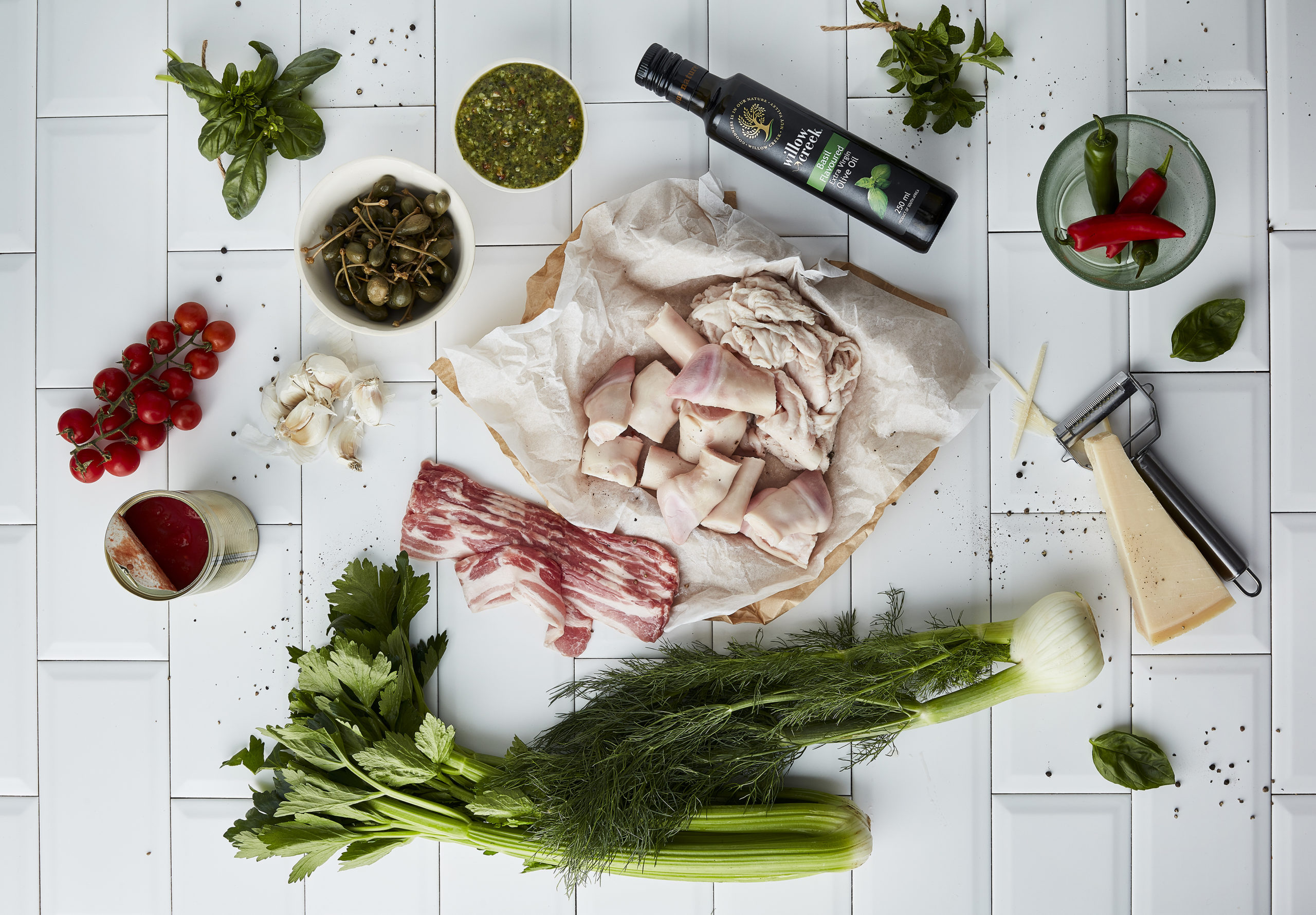
The ingredients for Trippa alla Roma / Roman Tripe and Trotters / Romeinse Pens en Pootjies Afval – lyrical in any language. (Photo: Supplied)
Serves 4 – 6
2 kg of Deli-Co Farmstyle Family Butchery tripe and trotters rinsed in 1 litre of water with two tablespoons of lemon juice or white wine vinegar
2 litres of prepared stock of your choice
500g of bacon cut into cubes
25ml of olive oil
3 large onions, chopped
5 cloves of garlic, grated into 25 ml of olive oil
2 carrots, finely grated
2 celery stalks, finely chopped
2 fennel bulbs chopped finely
½ teaspoon of smoked chilli flakes
500ml of Chenin Blanc
2 tins canned whole or chopped tomato
20g tomato paste
Small grated potato
Olive oil
Parmesan cheese
Caper berries
Fresh mint and basil
Salt and pepper
Method
Wash the tripe in a bit of vinegar water, strain and dry. Place in a pressure cooker with two litres of stock and cook for about 35 minutes; otherwise cook on a stove top in a large pot for two and a half to three hours. Strain liquid off return to the pot and reduce to a quarter
In a large pan, heat the olive oil and add the bacon, sauté till golden brown, remove with a slotted spoon, set aside and brown the onions in the same pan adding the garlic, carrots, celery, fennel, chilli flakes and cook through for about 20 minutes
Add the sautéed bacon, white wine, tomatoes, tomato paste and small grated potato
Add the tripe back into the pot with the reduced cooking stock and bake in a 180℃ oven for about an hour.
Serve with lashings of olive oil, grated Parmesan and chopped fresh mint and basil with caper berries
Serve with fresh warm ciabatta or some soft risotto blanco.
Portuguese lamb tripe
“I was hesitant to put lamb tripe on my menu in my first restaurant in Riebeek Kasteel called Bar Bar Black Sheep, not knowing how people would receive this dish with which I had fallen in love with from a very early age. To my surprise all the tripe aficionados and lovers of nose to tail eating started emerging in all shapes and forms.
“The town annually hosted a Mediterranean festival headed by my good friend Phillicus Olivier and we got to represent different Mediterranean countries each year. One of my favourite experiences was being able to cook Portuguese food and especially Portuguese tripe. Cooking tripe takes time and you need to be in the right mood so settle down with a good bottle of wine, some really good jazz music and enjoy the ride.
“This recipe is simple and uncomplicated. We serve it with a green kale spiced rice and loads of chopped fresh parsley.”
Ingredients
Serves 4 – 6
2 kg of Deli-Co Farmstyle Family Butchery whole tripe and trotters rinsed in 1 litre of water with two tablespoons of lemon juice or white wine vinegar
2 litres of prepared stock of your choice
500g of bacon, cut into cubes
25ml of olive oil
3 large onions, chopped
5 cloves of garlic, grated into 25 ml of olive oil
2 carrots, finely grated
1 teaspoon cumin
3 cardamom pods, crushed
2 cloves
2 cinnamon sticks
1 bay leaf
2 pinches saffron
1 large 200g piece of chorizo, sliced
1 teaspoon leaf masala
1 teaspoon turmeric
1 tin of white beans like cannellini or butter beans
Handful of chopped fresh parsley
Method
Wash the tripe in a bit of vinegar water strain and dry. Place in a pressure cooker with two litres of stock and cook for about 35 minutes; otherwise cook on a stove top in a large pot for two and a half to three hours. Strain liquid off, return to the pot and reduce to a quarter.
In a large pan, heat the olive oil and add the bacon, sauté till golden brown, remove with a slotted spoon, set aside and brown the onions in the same pan adding the garlic, carrots, cumin, cardamom, cloves, cinnamon sticks, bay leaf, saffron, chorizo, masala and turmeric and cook through for about 20 minutes.
Add the tripe back into the pot with the reduced cooking stock and bake in a 160℃ oven for about an hour and a half.
Remove from the oven and mix in the tin of beans. Heat through and serve with loads of fresh chopped parsley and green kale spiced rice. DM/TGIFood






 Become an Insider
Become an Insider
Comments - Please login in order to comment.